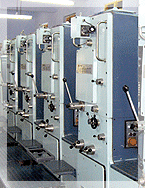|
|
|
|
 |
 |
 |
|
| Offset printing
is a widely used printing technique where the
inked image is transferred (or "offset")
from a plate first to a rubber blanket, then
to the printing surface. When used in combination
with the lithographic process, which is based
on the repulsion of oil and water, the offset
technique employs a flat (planographic) image
carrier on which the image to be printed obtains
ink from ink rollers, while the non-printing
area attracts a film of water, keeping the nonprinting
areas ink-free. |
 |
 |
| |
|
|
The
advantages of offset printing include:
- Consistent high image quality —
sharper and cleaner than letterpress printing
because the rubber blanket conforms to the
texture of the printing surface.
- Usability on a wide range of printing
surfaces in addition to smooth paper (e.g.,
wood, cloth, metal, leather, rough paper).
- Quick and easy production of printing
plates.
- Longer plate life than on direct litho
presses — because there is no direct
contact between the plate and the printing
surface.
|
|
|
|
|
| |
|
|
 |
|